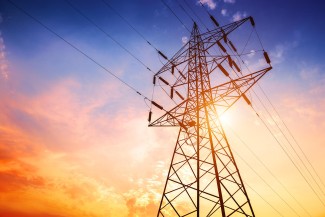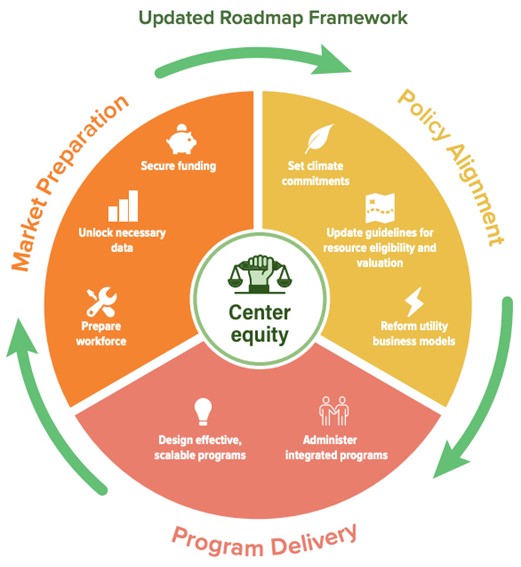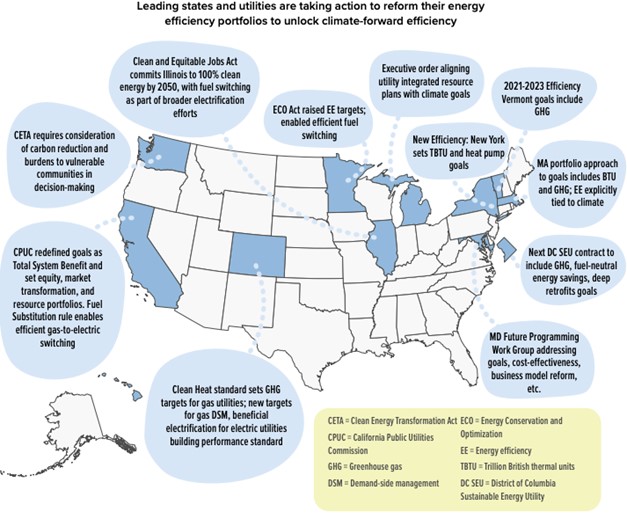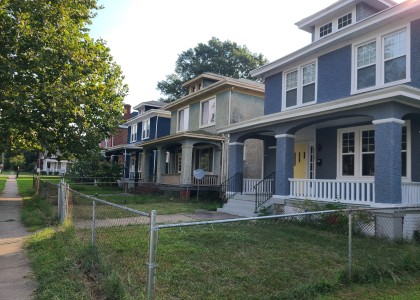Across the United States, utilities are giving customers incentives to buy equipment that may do a great job of cutting energy use but fall short in cutting emissions. How can these incentives optimize both? Nine strategies can help shift utility energy efficiency programs so they no longer focus solely on reducing energy use but instead also reduce planet-warming emissions, according to a report released today by the American Council for an Energy-Efficient Economy.
The report, A Roadmap for Climate-Forward Efficiency, is the second part of the Climate-Forward Efficiency Initiative. This initiative aims to assist legislators, utilities, and regulators in realigning utility energy efficiency programs to prioritize greenhouse gas (GHG) reductions. It launched last year with another report that showed the need for these programs to focus on decarbonizing the economy and meeting climate goals. As we move forward, we invite stakeholders to join us in advancing this transformation.
To better understand what a climate-forward efficiency future may look like, and how we get there, let’s take an imaginary journey through a future in which stakeholders are using energy efficiency programs to address our climate crisis. Though idealized, these steps reflect actions that some states, utilities, and regulators are currently taking throughout the United States.
At the heart of the journey is the need to ensure that climate-aligned energy efficiency programs benefit all customers. Low-income customers, residents of environmental justice communities, and other underserved groups are disproportionately hurt by climate change and high energy bills. States, utilities, and regulatory commissions begin by engaging these communities and their stakeholders in planning and decision-making. They collect equity-related data about building conditions, local pollution, demographics, and other factors.
They then set accountability standards, like the District of Columbia’s requirement that the DC Sustainable Energy Utility channel 35% of its program funding through certified community-based or women/minority-owned local businesses and organizations. Regulators can even tie utility compensation to meeting equity targets.
Our journey continues to the state legislature, where lawmakers set climate targets and policy mandates to limit average global temperature increase to 1.5°C, as about half of U.S. states have already done. Doing so opens the door for a wide range of decarbonization actions. One such activity is clarifying the responsibilities of the state’s regulatory commission, as Maryland did in May 2021 when it updated the charge of its Public Service Commission to consider climate change and fair labor standards during rulemaking. These initial steps can empower utilities to set energy efficiency program goals and investment plans that align with climate commitments.
With the high-level guidance in place, legislators continue to remove roadblocks. They redefine the efficiency measures ratepayers can support, as Minnesota did with its 2021 Energy Conservation and Optimization Act. This law removed prohibitions against “fuel switching,” allowing utilities to incentivize technologies that will save the most energy and avoid the most emissions, regardless of which fuel powers them.
Utilities deserve to financially benefit from well-designed and -executed climate-forward efficiency programs. State legislators can help by setting or updating revenue decoupling, which provides utilities with revenue independent of the volume of energy they sell. Regulators continue the process by approving performance incentives that financially reward utilities for achieving desired climate-forward efficiency outcomes, and by reforming electric rates that reward customers for saving energy during high carbon emission periods. Regulators further encourage utilities to procure the most cost-effective, climate-aligned resources, regardless of ownership or technology.
Once legislators have set the table for climate-forward efficiency, utilities begin to design new efficiency programs that are easy for customers to access. Utilities understand that programs only work with customer buy-in, so they test and adjust their marketing messages to ensure customers are being engaged in ways that appeal to what they care about. Utilities also take steps to transform and strengthen the market for low-carbon technologies. They may choose to emulate Efficiency Vermont’s heat pump, space-heating, and water-heating program, which offers a $600 incentive to distributors in addition to discounts for income-qualified customers.
A truly holistic decarbonization strategy will involve a combination of energy efficiency, demand flexibility, electrification, renewable energy, and storage. Utilities simplify these solutions by bundling measures together for customers. They may choose to follow the model of NYSERDA’s Comfort Home Program by offering staged upgrades that encourage homeowners to invest in envelope and duct improvements before replacing fossil-fueled heating systems with high-efficiency cold climate heat pumps.
Regulators approve and encourage the use of energy consumption data to help utilities focus their efficiency efforts. Those data include forecasts of future grid GHG emissions and more-detailed energy efficiency savings estimates. By lowering the barriers to obtaining these data, legislators and regulators make it easier for others to develop innovative solutions. For example, Recurve, a clean energy solutions software company, has used California’s energy data access to develop its FLEXvalue engine for computing grid and carbon benefits of demand-side measures.
Utilities collaborate with state agencies on regional workforce studies to assess workforce trends and communicate the number of skilled workers required to meet local goals. Programs such as New York State’s Workforce Development Initiative and Massachusetts’s Workforce Skills Cabinet show how to leverage statewide funds for regionally customized workforce development projects. Utilities support pre-apprenticeship programs to diversify the pool of workers, and provide adequate accommodations and compensation to help those workers find rewarding careers. Regulators may choose to follow the California Public Utility Commission model of requiring utilities to report on how ratepayer dollars are addressing job quality, access, and workforce development.
To avoid burdening ratepayers with the full cost of climate-forward efficiency policy goals, utilities leverage federal funding, such as the U.S. Department of Energy’s State Energy Program to support energy audits and building retrofits. They also take advantage of regional, state, and local funding, such as using Regional Greenhouse Gas Initiative proceeds to weatherize low-income households. In addition, utilities piggyback climate-forward efficiency goals onto existing programs. For example, the Los Angeles Department of Water and Power partners with other City of Los Angeles departments to conduct building energy audits by piggybacking on a city program that inspects premises for habitability.
Moving forward with these strategies
While this particular journey was imaginary, the above examples and the map below show that statehouses, utilities, and public utility commissions have already adopted pieces of this vision. These leaders demonstrate that it is entirely possible to use utility energy efficiency programs to meet deep decarbonization goals. If we care about protecting customers, our economy, and our environment, it is time to make this journey a reality for the rest of the country.





